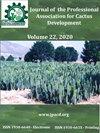活性炭对龙果愈伤组织发育及真菌污染的影响
IF 0.4
4区 农林科学
Q4 HORTICULTURE
Journal of the Professional Association for Cactus Development
Pub Date : 2021-03-25
DOI:10.56890/jpacd.v23i.375
引用次数: 1
摘要
活性炭通常用于植物组织培养系统,以减少酚类氧化并改善细胞生长发育。研究了活性炭对火龙果实体细胞胚胎发生的影响。将9个月大的种子衍生的火龙果茎放置在补充有2,4-D(1.5mg/l)和活性炭(1g/l)的Murashige和Skoog(MS)基板中。培养物在连续光照或黑暗条件下培养14小时。不含活性炭的MS培养基作为对照。评估真菌污染百分比、组织褐变程度和愈伤组织生长(长度、宽度和总面积)。在含有活性炭的培养基中接种(dai)四天后,无论使用何种光照条件,都观察到污染显著减少(p<0.05,T检验分析)。相反,在培养8天后,两种处理之间的真菌污染没有发现显著差异(dai)。真菌污染物的鉴定是通过形态培养和分子分析相结合的方法进行的。真菌分离株在马铃薯葡萄糖琼脂培养基上显示出厚而白色至浅灰色的菌丝体,不产孢7代。DNA序列分析显示,分离株与两个双孢子虫物种有很高的相似性。活性炭不影响愈伤组织的长度、宽度和总面积。结果表明,活性炭在火龙果组织培养中的应用可显著降低组织褐变(p<0.05)。此外,进一步研究真菌污染物在火龙果中的可能作用将是有价值的。还介绍了一种可用于评估火龙果组织褐变的特征量表。本文章由计算机程序翻译,如有差异,请以英文原文为准。
Dragon fruit calli development and fungal contamination as influenced by activated charcoal
Activated charcoal is often used in plant tissue culture systems to reduce phenolic oxidation and improve cell growth and development. This study investigated activated charcoal's effect on the somatic embryogenesis of dragon fruit (Hylocereus species). Nine-month-old seed-derived dragon fruit stems wereplaced in basal Murashige and Skoog (MS) plates supplemented with 2, 4-D (1.5 mg/l) and activated charcoal (1g/l). Cultures were incubated in 14 h continuous light or under dark condition. MS medium without activated charcoal served as the control. Percent fungal contamination, degree of tissue browning, and callus growth (length, width, and total area) were assessed. A significant decrease in contamination was observed four days after inoculation (dai) in a medium containing activated charcoal regardless of the light condition used (p<0.05, T-test analysis). In contrast, no significant difference in fungal contamination between the two treatments was found eight days after incubation (dai). Fungal contaminants’ identities were done using a combined morphocultural and molecular analyses. The fungal isolates showed thick and white to grayish mycelia without spore production seven dai in potato dextrose agar medium. DNA sequence analysis showed a high percent similarity of the isolates to two Diaporthe species. Activated charcoal did not affect the length, width, and total area of the calli produced. However, a significant decrease in tissue browning was recorded (p<0.05). Overall results demonstrated the applicability of activated charcoal in dragon fruit tissue culture to reduce in-vitrobrowning. Additionally, examining further the possible role of fungal contaminants in dragon fruits would be valuable. A hedonic scale that can be used to assess tissue browning in dragon fruit is also described.
求助全文
通过发布文献求助,成功后即可免费获取论文全文。
去求助
来源期刊

Journal of the Professional Association for Cactus Development
Agricultural and Biological Sciences-Plant Science
CiteScore
1.10
自引率
33.30%
发文量
10
期刊介绍:
The editors of the Journal of the Professional Association for Cactus Development, are very excited to be a part of the excellent editorial committee and to work together to create the synergism between scientists, growers, legislators, and business people so vital to the development of this industry to serve the people of arid lands.
 求助内容:
求助内容: 应助结果提醒方式:
应助结果提醒方式:


